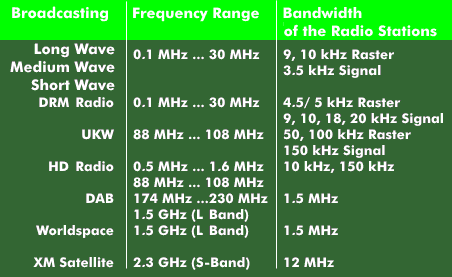digital radio mondiale (audio codec) (DRM)
Digital Radio Mondiale(DRM+ is similar in approach to Digital Audio Broadcast( DAB) and relies on the classic AM range oflong wave, medium wave and short wave. Since the current transmission quality is severely impaired by distortion, noise and intermodulation, this can be remedied by means of digital broadcasting.
In the above-mentioned broadcasting ranges, the reproduction quality corresponds to that of VHF broadcasting. Corresponding test broadcasts taking into account the different wave propagation such as spatial wave and ground wave make it clear that DRM radio can compete with FM and is suitable for stationary and mobile reception. The European Telecommunications Standards Institute( ETSI) has published the specifications for DRM radio in the technical standard TS 201 980.
Transmission method for DRM radio
DRM radio uses Coded Orthogonal Frequency Division Multiplex( COFDM) as the transmission method, combined with Equal Error Protection( EEP) for error protection and audio compression. For audio compression, MPEG-4AAC compression with Spectral Band Replication( SBR) was chosen. For voice transmissions, MPEG-4 Code Excited Linear Prediction( CELP) or Harmonic Vector Excitation( HVXC) is used. The number of carrier signals and symbol duration depend on the four possible operating modes, which determine the transmission quality under different propagation conditions.
The DRM technique is designed to use the existing AM frequency bands and channels, i.e., to operate with the existing bandwidths of 9 kHz and 10 kHz, respectively. With a channel bandwidth of 9 kHz, the transmission rate for the user data is between 7.6 kbit/s and 30.8 kbit/s, depending on the protection class. In addition, the technology offers operating modes for very narrow frequency bands of 4.5 kHz and 5 kHz and for bandwidths of 18 kHz and 20 kHz. With a transmission bandwidth of 10 kHz, audio signals with a bandwidth of 15 kHz can be transmitted with these techniques.
Audio and data transmission in DRM radio
In addition to audio, digital data can also be transmitted, providing information about the music track and artist on appropriate displays. Likewise, additional information services can be integrated for traffic and weather information, current news or business news, among others. Accordingly, the DRM frame is composed of several service and channel frames. This results in several frame formats: The Transmission Frame, which can comprise 15, 20 or 24 symbols depending on the operating modes, and the Superframe formed from it. The transmission frame consists of the Main Service Channel( MSC), the Fast Access Channel( FAC) and has the Service Description Channel( SDC) at the beginning.
Since DRM radio can be broadcast over existing broadcast infrastructures, there is little investment required for the conversion. On the receiving side, a new receiver is needed. However, with major broadcasting stations such as Deutsche Welle and BBC no longer transmitting on short and medium wave, future prospects are not very optimistic.
DRM radio has already been extended to the VHF range up to 120 MHz and has the designation DRM+. With the channel spacing of 100 kHz available in FM broadcasting, transmission rates of 186 kbit/s and bandwidths of 96 kHz are realized.


.png)